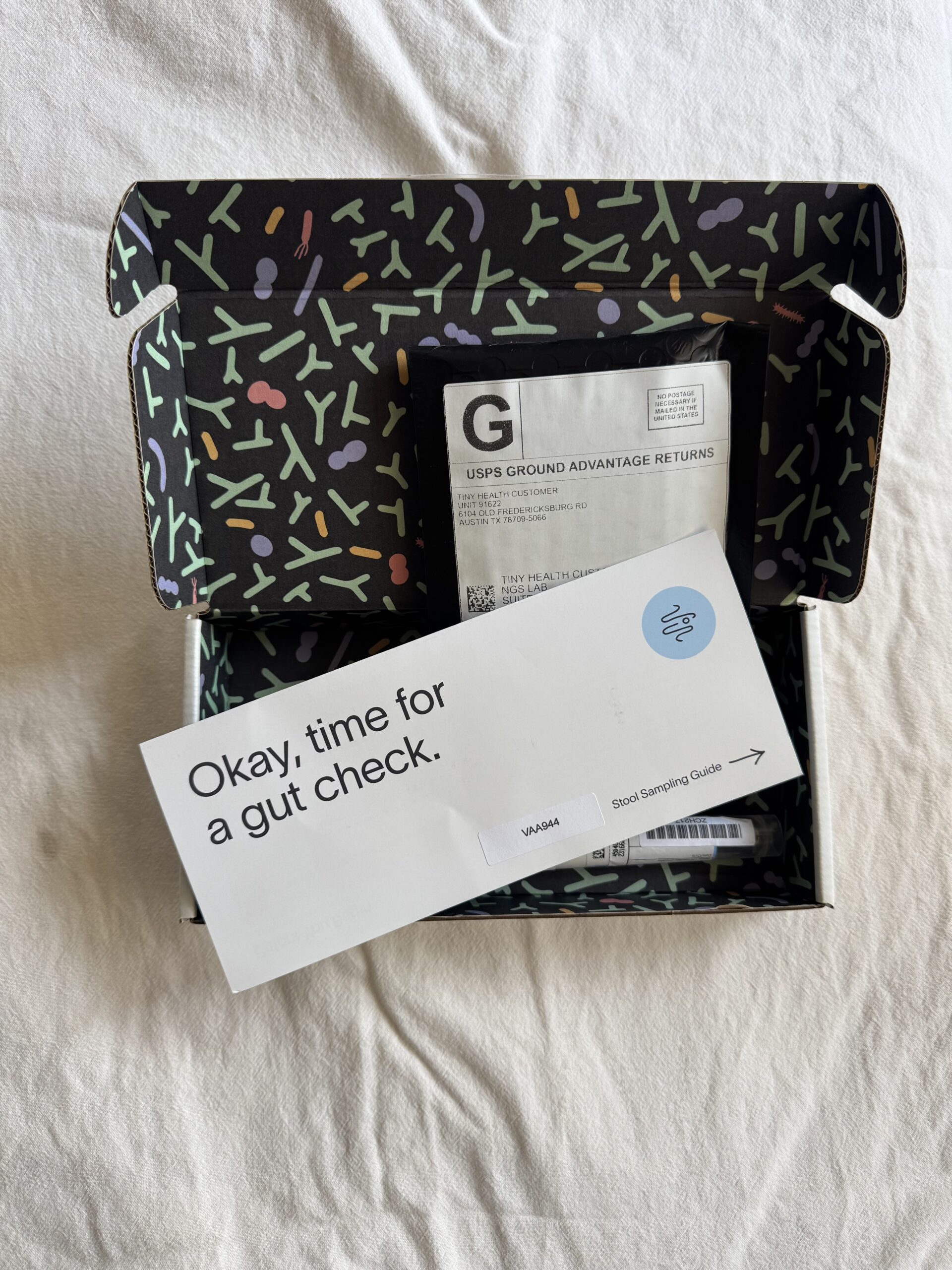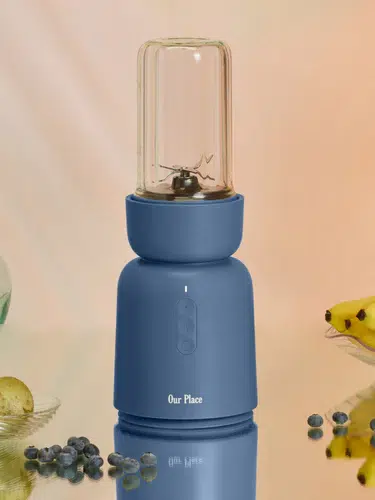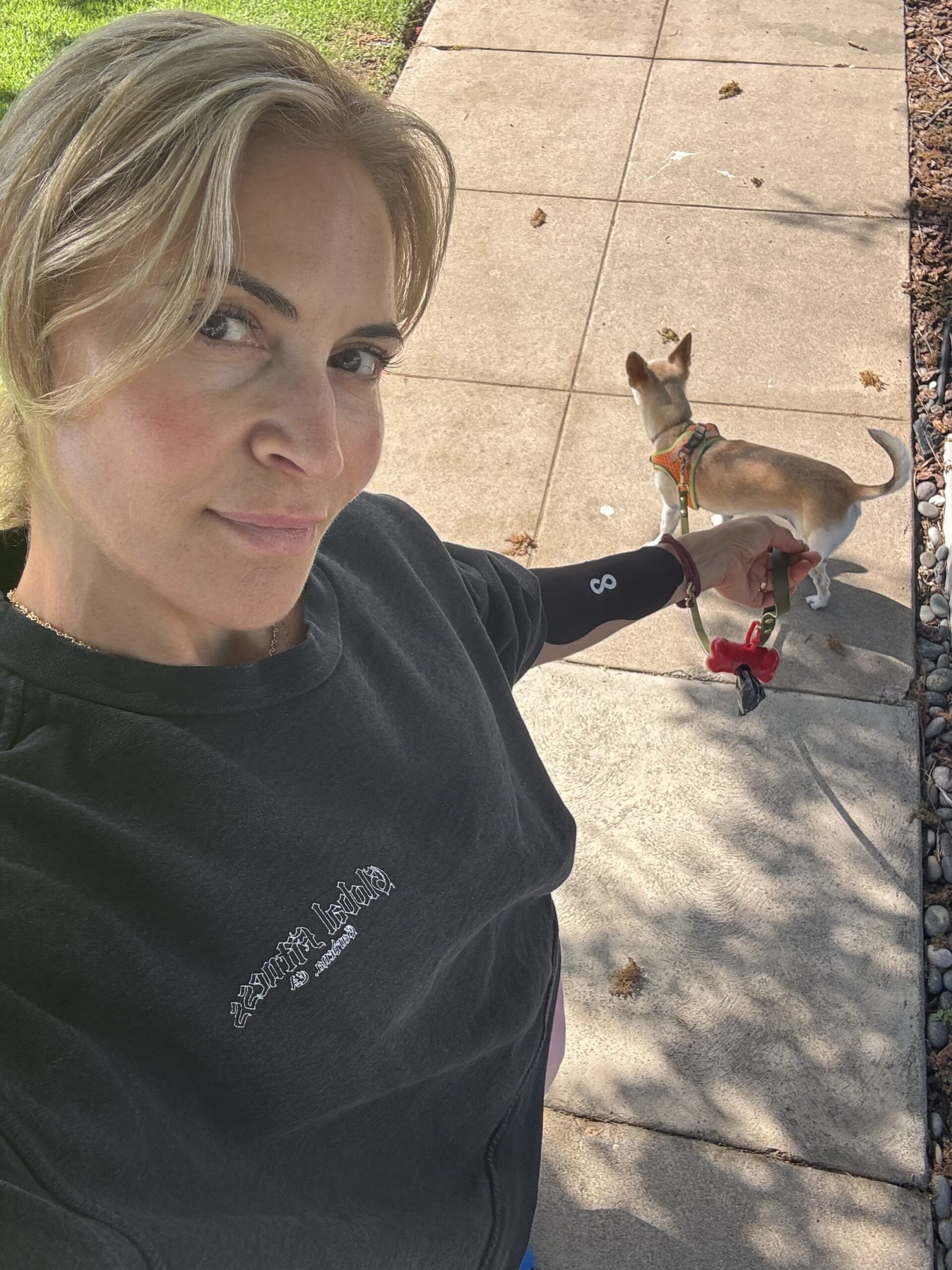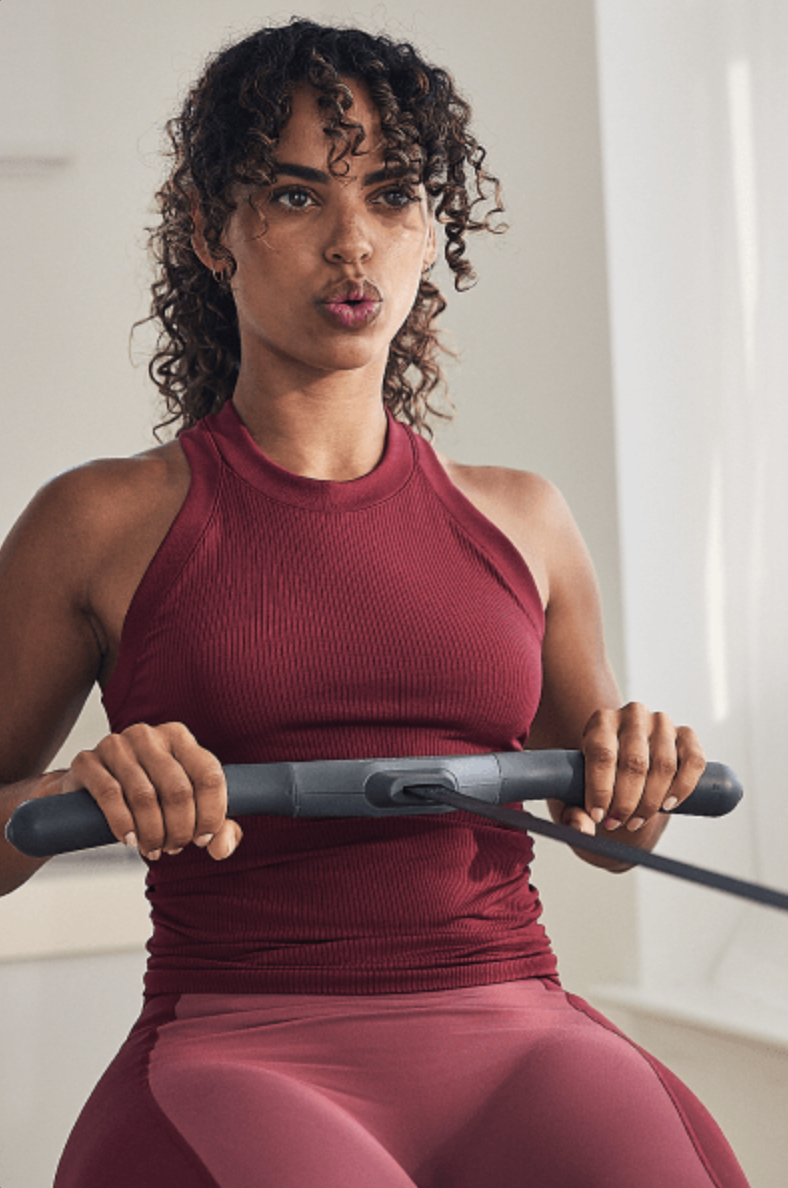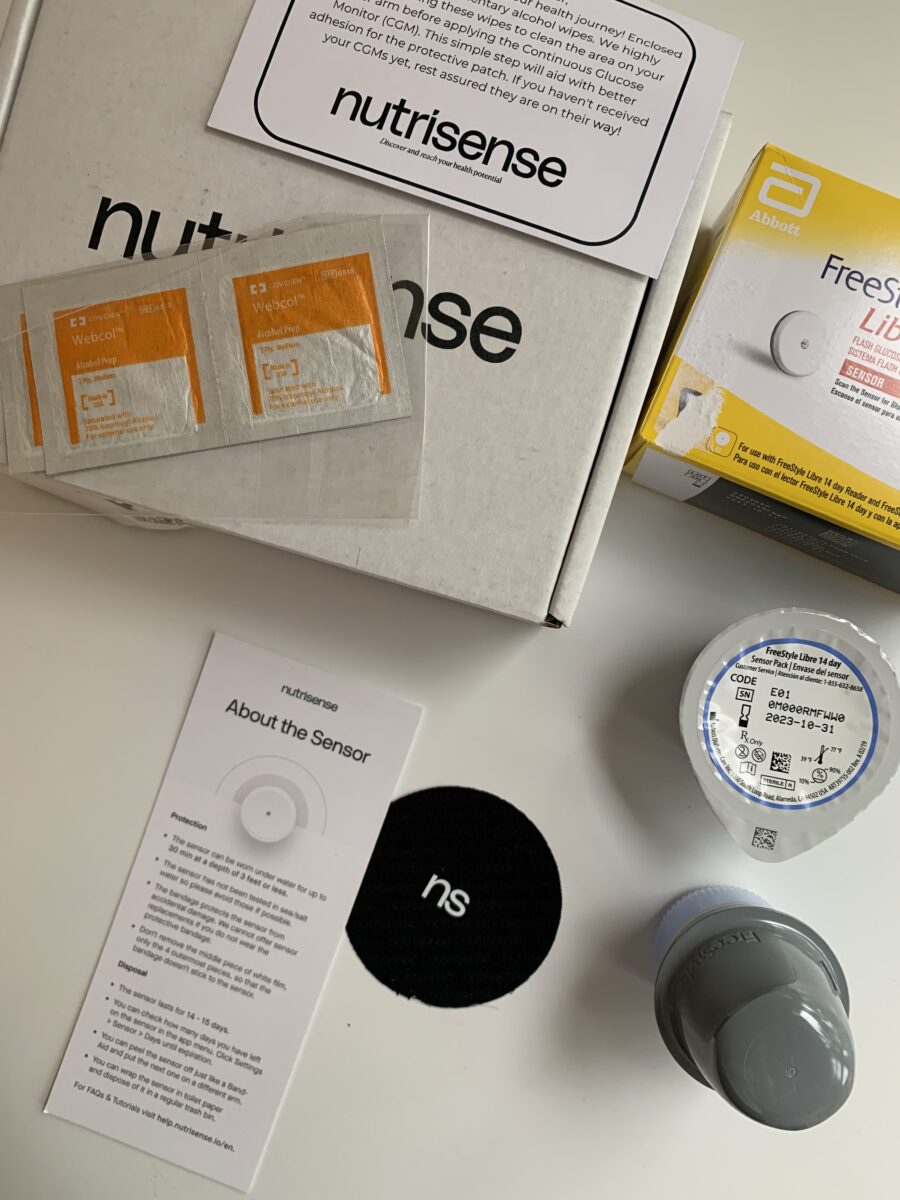
I Tried Nutrisense To Monitor How My Body Reacts To Different Foods
Good Gear editors endorse products we’ve personally researched, tested, and genuinely love. Learn more about our methodology and business model here.
GOOD GEAR RATING — 8/10 STARS
Summary: After 30 days of testing, we highly recommend Nutrisense as a CGM option. It offers valuable insight into blood glucose levels and exciting data on how foods impact our energy levels and overall health. The main drawback is the cost, and having to frequently scan the CGM and log your foods.
PROS
- The app is easy to use and integrates with some of our other favorite wearable devices, like the Oura Ring. We also love that you can scan barcodes for your food and create your favorite meals.
- The CGM is easy to apply at home by yourself. It’s a quick and painless application process!
- If you opt for the nutritional support in your plan, you have access to texts and chats with a real live nutritionist for questions, feedback about your entries, and more
CON
- Depending on your plan, CGMs can cost up to $299/month. Nutritional support is an added cost each month ($100)
I’ve always been a bit nerdy when it comes to health data. I love learning how my body is or isn’t responding to food, sleep, exercise, etc. I’ll be the first to rationalize some expensive home test or lab work to check my hormones, genetics, and vitamin and mineral levels.
So when I heard about CGMs (continuous glucose monitors) and discovered that a friend was wearing one, I was intrigued. CGMs are most known for helping people with diabetes monitor their glucose levels — but this friend didn’t have diabetes. Instead, she wore the monitor on her arm to help her get better insight into how different foods impacted her energy levels. Being the curious and willing participant I am when it comes to health devices, I jumped at the opportunity to try one for myself.
There are a few different companies offering CGMs, but the one that caught my eye was Nutrisense, which I decided to test. The website is warm and inviting, which is helpful if you’re new to the space and feeling a bit intimidated. I also found the Nutrisense blog invaluable during my trial for additional reading and information — but more on that and how it works below.
About Nutrisense
First, a bit of background about the company. Nutrisense was founded in 2019 by Alex Skryl, Kara Collier, and Dan Zavorotny. Their goal was to disrupt the traditional health space with a preventative approach. Believing CGMs to be the missing piece in every individual’s health journey for understanding your metabolism, the three founders created a sleek and simplified health tool that is often seen as clinical and/or a burden. In the most basic sense, they created a company and CGM that is accessible, easy to understand, and — dare I say — actually cool.
What is a CGM?
Okay, that’s all great, but what is a CGM, and how does it work?
A CGM is a small device, or wearable sensor, that goes directly under your skin (usually on your arm) and monitors your glucose values in real-time. According to Medical News Today, they work when “a thin tube, or cannula, pierces the top layer of skin and measures glucose in the interstitial fluid. This is the fluid that surrounds cells in the body and provides a similar reading to blood glucose.”
With Nutrisense, you apply the sensor and scan throughout the day (using the app on your phone) to upload new readings. You can see how your glucose levels rise, dip, or stay consistent as you input your meals and activities.
But CGMs can help with more than understanding your glucose levels and metabolism. In addition to real-time glucose monitoring and seeing glucose responses to meals, it can help analyze the impact of fasting, meal timing, physical activities, stress, sleep, habits, and more.
Receiving and applying the CGM
Shipping and delivery were all incredibly easy. The brand set me up with an account for the app, and I was introduced to my dietitian, Kasey. I also filled out a few forms to note my primary goal: to see how food impacts my daily glucose levels. I also let Kasey know I was curious to see how my glucose levels changed throughout my menstrual cycle, and how energy levels coordinated with my readings.
When the CGM arrived, I was relieved to find comprehensive instructions for application. Even though I’ve done home tests before with needle pricks, I’m always a bit woozy when it comes to poking myself (even if the manual promises it will be painless).
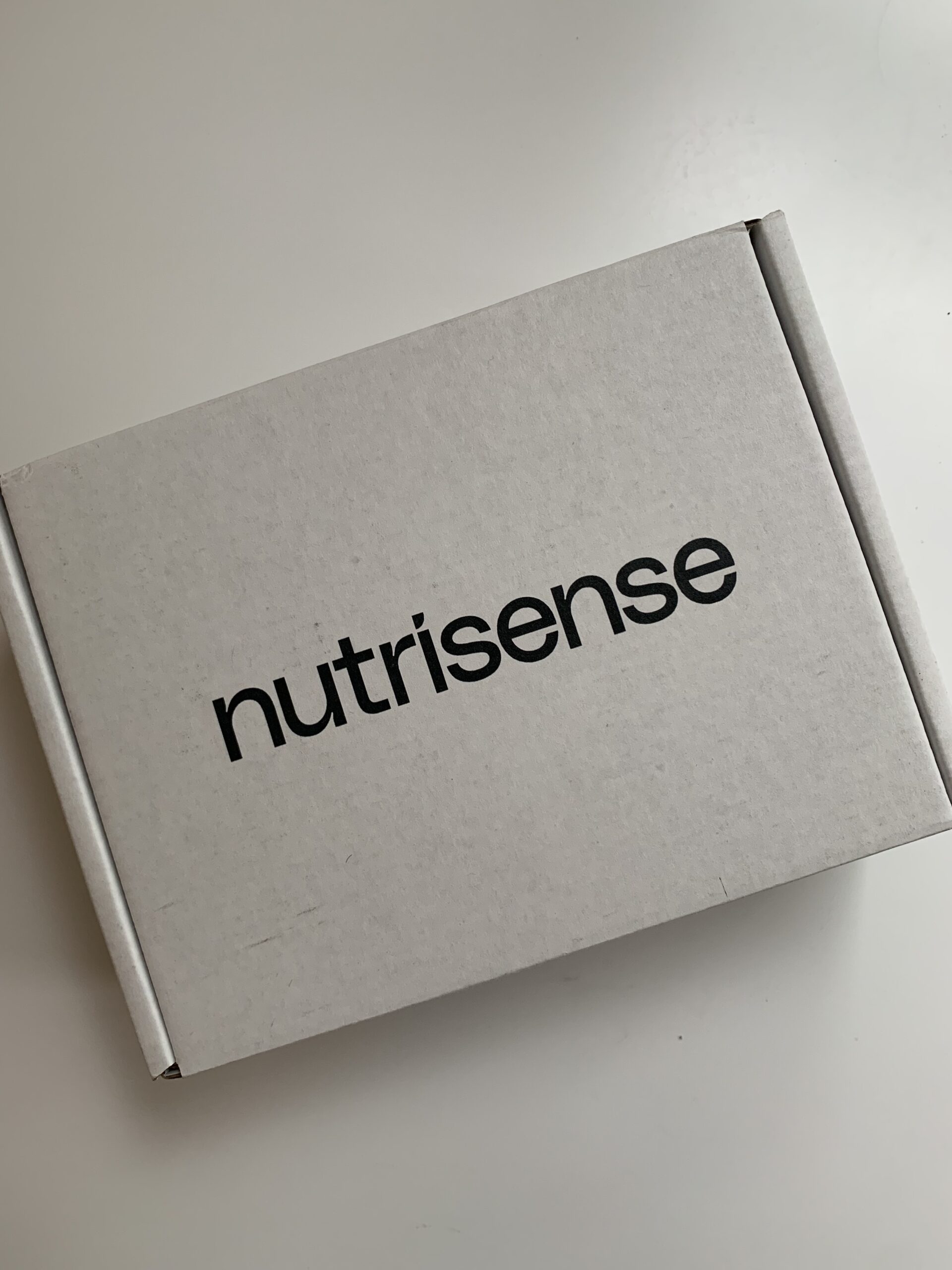
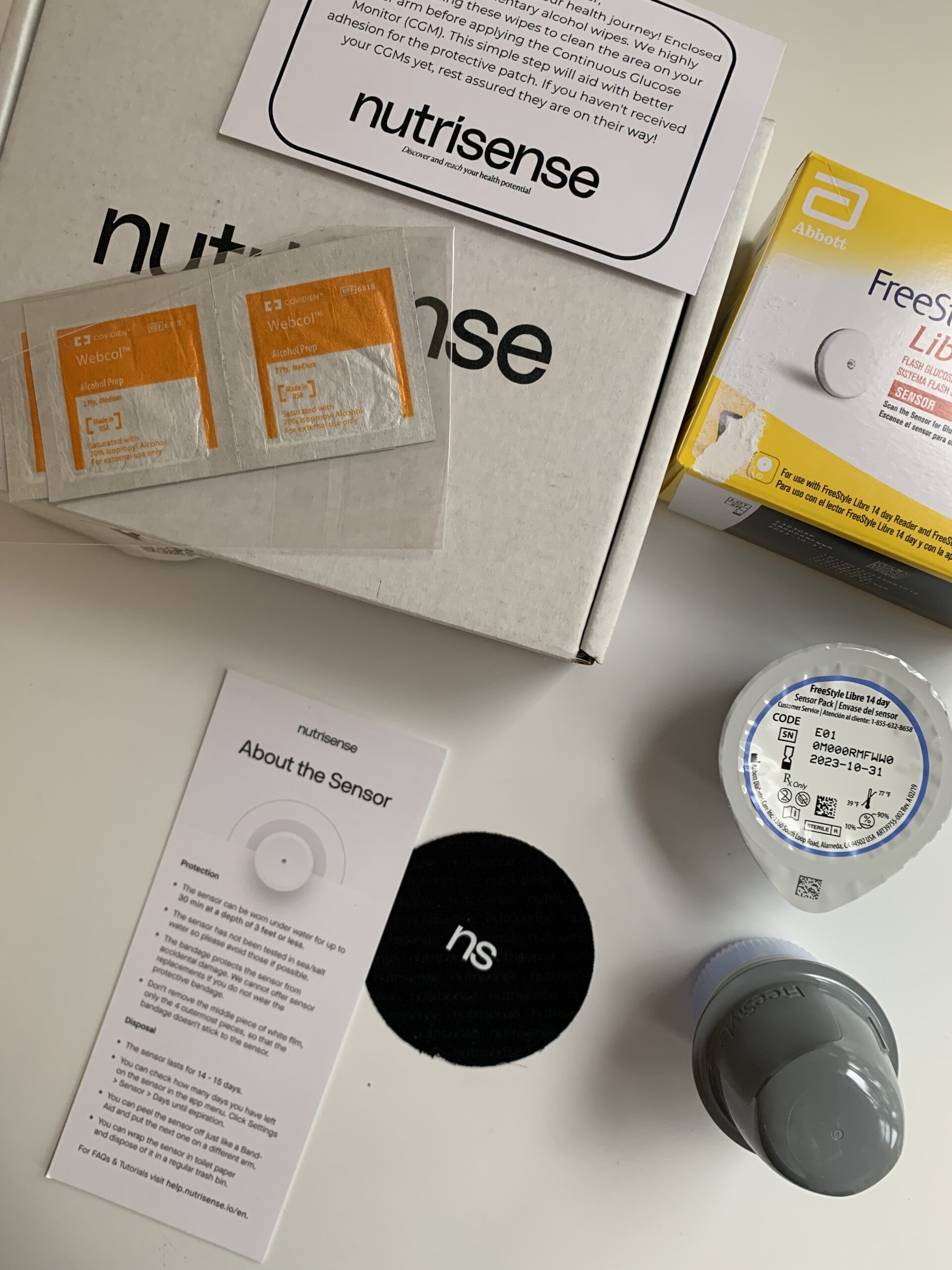
To apply the Nutrisense CGM, I followed the instructions to clean the skin on the back of my arm. While the sensor can be applied solo — I did this for my second sensor — I had my husband help with the first application to ensure placement was centered on the back of my arm.
As promised by the brand, I didn’t even feel the poke of the sensor going on — it just looked like a teeny tiny needle. A quick press of the spring-loaded device against my arm and the sensor stuck. I then placed the black sticker over the sensor to protect it for the next 14 days, the lifetime of the sensor before it needs to be replaced. Though it’s waterproof and sweatproof, Nutrisense recommends “wearing a CGM arm band or protective patch is recommended to avoid accidental dislodging of the device.”
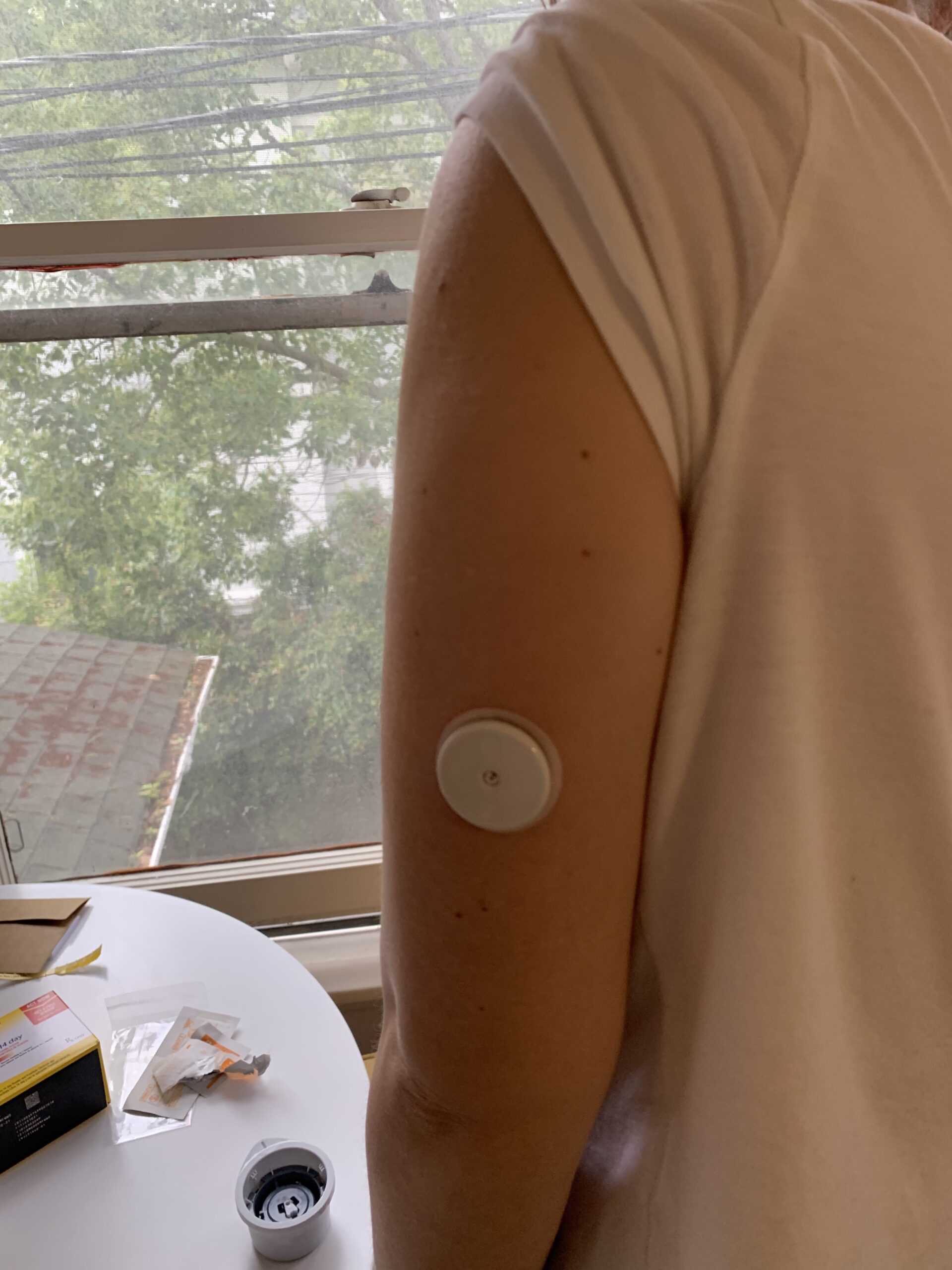
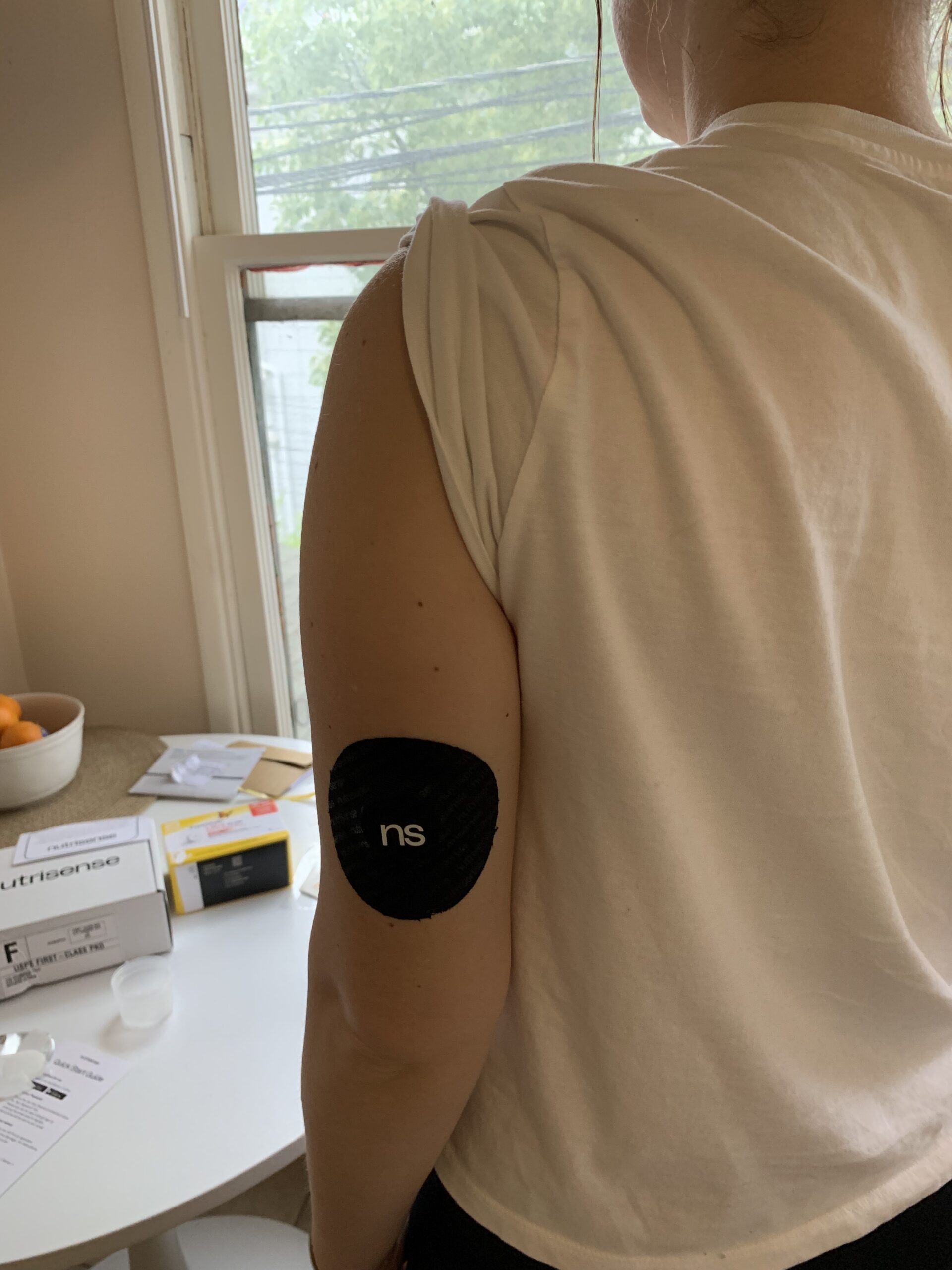
Logging and interpreting my first meals
Kasey let me know that it would take about 12–24 hours for my sensor to calibrate once it was applied. From there, she instructed me to scan my CGM at least once every 8 hours while also logging meals, exercise, sleep, and stress in real time. I also wear an Oura Ring so the app calibrated my sleep and exercise data, which was extremely helpful. This left me to focus on logging food and creating “favorite meals” to save time on future entries.
My first few meals with Nutrisense happened while we were out of town, so I saw how wine, desserts, and food outside my regular routine impacted my glucose levels. I expected my data to be all over the chart, so I was surprised that the high-sugar foods didn’t spike my blood glucose as anticipated — though they were all notably consumed after having protein and/or high meal scores.
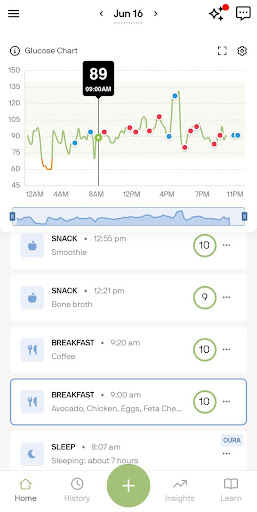
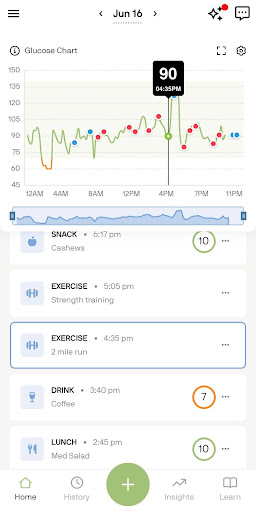
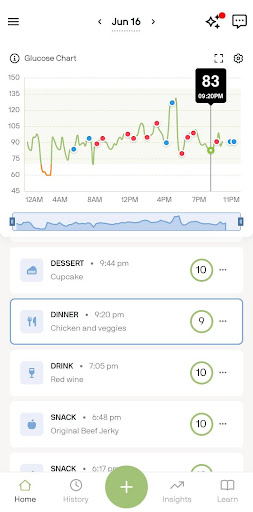
Nutrisense grades meals between 1 and 10 depending on how your blood sugar peaks after consuming certain foods. The time your blood sugar spends elevated and how quickly it recovers also impacts the score. As we can see from data on this first day of meal tracking, my blood sugar was only out of range during sleeping hours. When I asked Kasey about this, she said it was likely because of excess pressure blocking blood flow to the CGM, which makes sense since I’m a side sleeper.
Oh, and the coffee. Sad news for all-day coffee consumers! While my late afternoon coffee didn’t produce a total bummer score, recovery was less than optimal. (Though, I would have still enjoyed it having known the data.)
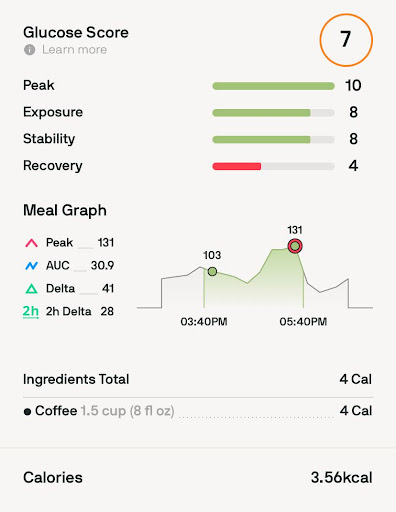
I asked Heather Davis, M.S., R.D.N., L.D.N., and technical writer with Nutrisense about the fluctuations (and lack thereof) that I was seeing. Regarding neutral responses, she offered, “There are a few things that could be going on here. One is that the body was able to mobilize that glucose from your carbs/sugars very efficiently for energy production. This is commonly seen when we might be engaging in more activity before and/or after eating.” Regarding “spikes” after a balanced and healthy meal, Davis said, “This is quite common for many people! One reason is that our nutrition needs are incredibly personal and what we might have been told was ‘healthy food’ by the popular media may not tell the whole story about how your body will respond.” Davis provided an entire list of factors that influence your unique reaction to any food:
- individual glucose tolerance (and genetics play a role here)
- food sensitivities
- digestive health
- the meal timing and composition
- your activity levels
- your stress levels
- other hormonal factors
- other medical conditions you might have
- and more!
She warns that we also have to consider what counts as a “spike.” “Some glucose variability or fluctuation is completely normal and healthy, but we want to avoid the more dramatic swings. We set some parameters in our app for how to gauge glucose variability based on some of the research currently available. I usually encourage people to try to avoid standard deviation scores above 20,” she said.
Note that different food combinations and meal times can have a big impact on your glucose variability. It turns out what I experienced on vacation wasn’t a fluke. If you are experiencing large fluctuations, you can try eating proteins before carbs or shifting your overall eating window earlier in the day. Sometimes this will result in a better response to foods that were previously causing trouble.
The next four weeks
I wore Nutrisense for a total of 28 days, replacing the sensor once, and here are the biggest trends I noticed in my health data:
- My body loves sleep and my glucose levels were more consistent throughout the day when I was well-rested.
- White wine is not my friend (a score of 4) — though red wine is.
- Unsurprisingly, my levels struggle to recover from coffee after 12 pm.
- My levels always skyrocket after running / HIIT training. I asked Kasey about this, and she said it’s common to see a higher glucose response with exercise that is high intensity because the current energy availability is not enough to meet the energy demands. She emphasizes this is normal and okay, stating that it’s only a concern if numbers frequently hit about 180 mg/dL. This blog post is an excellent resource for more information.
- Finally, and probably the saddest and most surprising discovery, my body doesn’t love all the sugars in oat milk lattes. Black coffee it is, then.
I will admit the CGM becomes tedious after a while since it requires manual inputting throughout the day. Unless you are familiar with food tracking and/or enjoy it, logging every meal and the amount you’re eating can be tiresome. This is where the “saved meals” and “favorites” become handy, especially if you eat similarly each day.
Final thoughts
I would also be concerned about anyone with struggles around counting calories and/or dieting. Receiving a “grade” for the foods you eat, may be triggering to some folks, so keep that in mind.
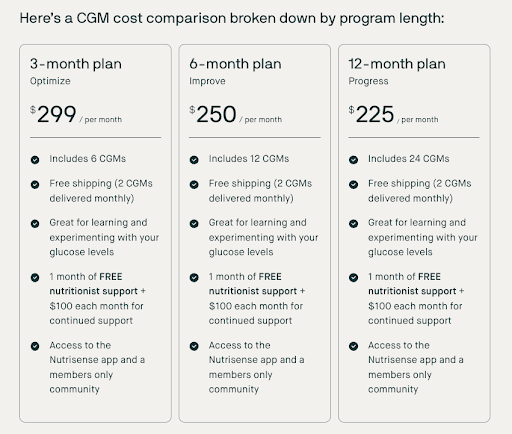
That said, I do think a CGM offers invaluable data and feedback for those who can afford the cost. And it is an investment. While Nutrisense offers various plans, the lowest option is $225/month + $100/month for nutritional support, and the CGM is not currently covered by any health insurance plans, though it’s HSA/FSA eligible.
While, as Davis warned me, a CGM is not a magic bullet, tracking my glucose levels did provide me some insight into my metabolic health and processes. (Again, more red wine. 🍷)
Combining this data with a comprehensive approach — working with a dietician, using other health tracking devices, and generally extending my curiosity beyond glucose levels only — is the best guarantee that you’ll get the full picture of your health concerns. Nevertheless, Nutrisense’s reliable and valuable insights on glucose levels could be a step in the right direction to closing the file on any unanswered questions about your health.
Kayti Christian is a Senior Content Strategist at The Good Trade. With an MFA in Nonfiction Creative Writing, her work has appeared in TODAY, Shondaland, and The New York Times. Since 2017, Kayti has been uncovering and reviewing the best sustainable home brands and wellness products. Her personal journey through four years of fertility treatments has inspired her to write extensively about women’s healthcare and reproductive access. Beyond her work at The Good Trade, Kayti is the creator of Feelings Not Aside, a Substack newsletter with 6,000 subscribers, and the cohost of the FriedEggs Podcast, which delves into IVF and infertility.
This review is not sponsored and includes the author’s personal experience. Good Gear editors were gifted this product. Read more about our review process here.

